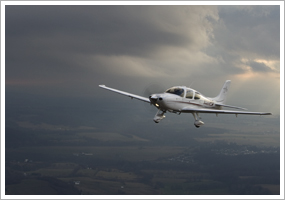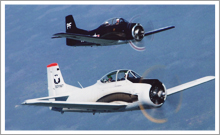| ||||
| | FT News | INSIDE AOPA | TRAINING PRODUCTS | FINAL EXAM | |||
TRAINING TIPsUpdating weather How to do it depends on where you are and what you need. While airborne, dial in the nearest continuous Hazardous Inflight Weather Advisory Service (HIWAS) broadcast. HIWAS also will provide any urgent pilot reports (pireps). If your departure has been delayed, or you have arrived at your first destination and want to learn about any changes to the forecast, flight service offers a briefing designed for your needs, explains the “FSS Tip of the Week” in the June 13, 2008, AOPA ePilot Flight Training Edition : “Just ask for an abbreviated briefing, provide basic background information about your previous standard briefing, if applicable (and at what time you received it), and then request the information you want. Only requested items will be provided. For example, ‘I need an abbreviated briefing. I received a standard briefing for a flight in the Flagstaff area two hours ago. I just need the TAF for FLG and any new TFRs within 20 miles of the airport.’” You also may request this briefing by radio from Flight Watch while airborne. Remember that an abbreviated briefing only supplements your weather information. “Don't think of an abbreviated briefing as a shortcut to save time, however; you could miss important information. But, if a couple of hours have gone by since you received a standard briefing, an abbreviated briefing is a good way to see if anything has changed,” wrote meteorologist Jack Williams in “The Weather Briefing,” available for download from Flight Training Online. Whether you are waiting impatiently on the ground for fog to lift at your destination or checking surface winds at your base when returning home, keeping up with the trend will keep surprises to a minimum! YOUR PARTNER IN TRAININGLike most students, you’re probably looking to save money in training. There are myriad ways to do it, but sometimes spending more money is the key to saving it. Consider buying an airplane. For those who fly 100 hours or more a year, owning an airplane can be cheaper than renting, and there won’t be any scheduling hassles or delays. AOPA has all the resources you need to start. Begin your search on the Pilot Information Center’s aircraft ownership information page. Here you’ll learn about the various types of ownership, how to make your dream a reality, and all the other considerations that go with having your own pair of wings.
Did you know that student pilots who join AOPA are three times more likely to complete their flight training? Membership includes unlimited access to aviation information by phone (800/USA-AOPA, weekdays from 8:30 a.m. to 6 p.m. Eastern time) or from AOPA Flight Training Online or AOPA Online. If you're not already a member, join today and get the pilot's edge. Login information is available online. FLIGHT TRAINING NEWSDWC students hold protestBraving pouring rain and a cold wind in New Hampshire, 40 students and alumni turned out March 30 to protest the decision to ground the Daniel Webster College flight operations major. The protest was the latest in a series of public displays of support for the program, and comes a week after DWC’s owner, ITT Educational Services, made its intent to close the program publicly known. Marcia Wescott, a DWC alumna who helped organize the protest, said the range of participants was great. There were current flight students, alumni, and even Daniel Webster students from unrelated majors, she said. Read more >> Sennheiser donates headsets to Florida CAPThe Florida wing of the Civil Air Patrol recently received a donation of aviation headsets valued at approximately $20,000 from Sennheiser. The headsets were distributed to CAP squadrons throughout the state, and they will be used by more than 1,800 cadets who are pursuing careers in aviation. Sennheiser’s contribution included headsets from its HMEC 356, HMDC 372, HME 105, and HMEC 355-C lines. Alaska pastor helps rural teens get their wingsPastor Grant Funk is on a mission to help Alaskan teenagers become pilots and mechanics. Funk is part of a new nonprofit organization that is helping teenagers at three rural high schools to take flight lessons for class credit. Students at one school are building a Thorp 211 light sport aircraft that they hope to fly in May. Funk’s organization is working to get flight instructors at village schools across the state. Even in Alaska, where general aviation flying is prevalent, aviation programs are rare in rural high schools, he said in a report in The Tundra Drums . Safety Spotlight shines through the cloudsWhether you’re brushing up for an instrument proficiency check, studying for a checkride, or looking for advice on how to keep from inadvertently flying into instrument meteorological conditions, the AOPA Air Safety Foundation safety spotlight on instrument flight rules has courses, quizzes, presentations, and publications relevant to your next flight, all gathered in one convenient place. Learn about everything from weather systems to the regulations—and listen to one Real Pilot Story of how a pilot with clouds above, clouds below, and thunderstorms on either side lost her vacuum pump and landed safely. inside aopaHertz offers special savings to AOPA membersAs an AOPA member, renting your next vehicle from Hertz not only gives you up to 25 percent off and free enrollment in the #1 Club Gold Program, but also will grant you special bonus savings. Save up to $35 off a weekly or weekend rental at the airport when PC#142564 is included in your reservation of an economy or higher class car. Plus, a portion of all revenue generated will be returned to AOPA and reinvested to support the association’s daily efforts to maintain the freedom, safety, and affordability of general aviation. The offer is valid for pickup through May 31, 2010. Reserve your car today. Is your certificate at risk?Spring is here, and for many pilots that means less time on the ground and more time in the air. Unfortunately in today’s climate for general aviation, any flight you take could put you at risk of violating any one of at least 700 relevant federal aviation regulations with which pilots are required to comply. Fortunately, for as little as $33 per year you can enjoy peace of mind every time you fly knowing that if you face a federal enforcement procedure you’ll have the best legal advice and support available anywhere. Read more >> TRAINING PRODUCTSWings Communications headsetsLooking for an inexpensive headset that offers good value for the money? Try Wings Communications’ line of passive noise reduction models, including the foldable WCH780, which retails for $220, and the conventional WCH950W, a bargain at $212.
Note: Products listed have not been evaluated by ePilot editors unless otherwise noted. AOPA assumes no responsibility for products or services listed or for claims or actions by manufacturers or vendors. FINAL EXAMQuestion: What is wake turbulence and why should I avoid it? Answer: Wake turbulence is a disturbance in the form of counter-rotating vortices aircraft generate from their wing tips. These vortices are created when the wings generate lift causing a pressure differential between the upper and lower wing surfaces. This pressure differential creates a swirling airflow aft of the wing tips which trail downstream from the aircraft. Their strength is determined by the weight, speed, and shape of the wing of the aircraft involved. The most intense wake turbulence is encountered behind an aircraft that is heavy, clean (gear retracted and/or flaps retracted), and slow. Some wingtip vortices can attain rotational speeds in excess of 300 feet per second. One of the greatest dangers of encountering these phenomena is induced roll that can exceed the roll authority of the aircraft. For more information on wake turbulence see Aeronautical Information Manual chapter 7-3-1. Also, read “The Weather Never Sleeps: Wake Vortices” on Flight Training Online.
Got a question for our technical services staff? E-mail [email protected] or call the Pilot Information Center, 800/872-2672. Don’t forget the online archive of “Final Exam” questions and answers, searchable by keyword or topic. Picture Perfect
AVIATION EVENTS & WEATHER To include an event or to search all events in the calendar, visit AOPA Online. For airport details, including FBO fuel prices, see AOPA’s Airport Directory Online. Flight Instructor Refresher ClinicsThe next AOPA Air Safety Foundation Flight Instructor Refresher Clinics are scheduled in San Diego, Calif., Cincinnati, Ohio, and Ashburn, Va., April 10 and 11; Denver, Colo., Boston, Mass., and Salt Lake City, Utah, April 17 and 18; Tampa, Fla., Atlanta, Ga., and Indianapolis, Ind., April 24 and 25. For a complete schedule, see AOPA Online. Can’t make it in person? Sign up for the CFI Refresher Online. AOPA Air Safety Foundation Safety SeminarsAOPA Air Safety Foundation Safety Seminars are scheduled in Pittsburgh, Pa., April 5; Springfield, Mo., and New Cumberland, Pa., April 6; Allentown, Pa., April 7; King of Prussia, Pa., April 8; Lynchburg, Va., April 13. Topics vary—for details and a complete schedule, see AOPA Online. | Got news? Contact ePilot. Having difficulty using this service? Visit the ePilot Frequently Asked Questions now at AOPA Online or write to [email protected]. |
| Member Tools : Send feedback | Update member profile | Change email address | Unsubscribe | ePilot Archive Editorial Team: ePilot Flight Training Editor : Ian Twombly | ePilot Editor: Sarah Brown | Contributor: Alton Marsh |

 “When should I update my weather briefing?” Many student pilots ponder this excellent question when planning a solo cross-country flight or while en route. The short answer is, “As often as possible.” Another guideline is to update your weather any time your information seems stale. If special weather reports were included in your briefing, that’s a clue to stay tuned. If conditions you are observing don’t meet expectations, get busy and find out why.
“When should I update my weather briefing?” Many student pilots ponder this excellent question when planning a solo cross-country flight or while en route. The short answer is, “As often as possible.” Another guideline is to update your weather any time your information seems stale. If special weather reports were included in your briefing, that’s a clue to stay tuned. If conditions you are observing don’t meet expectations, get busy and find out why.


